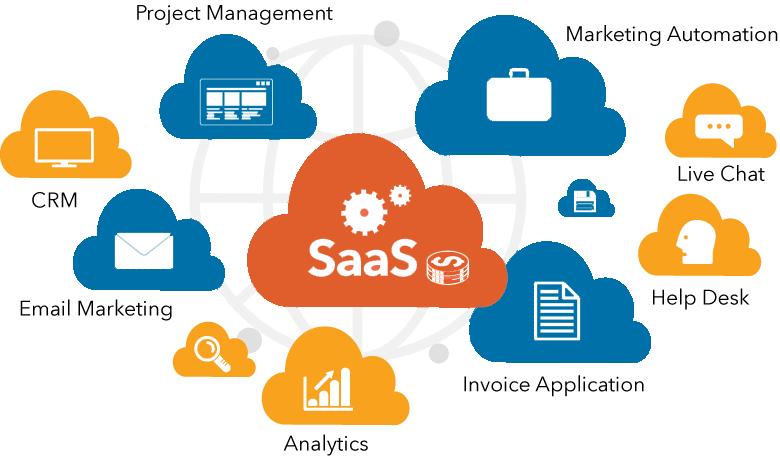Unleashing the Power of SaaS in Cloud Computing: A Comprehensive Guide

In today’s rapidly evolving digital landscape, Software as a Service (SaaS) has emerged as a game-changer, revolutionizing the way businesses access and utilize software applications. Coupled with the scalability and flexibility of cloud computing, SaaS offers unparalleled advantages in terms of cost-effectiveness, accessibility, and efficiency. In this guide, we’ll delve into the world of SaaS in cloud computing, exploring its benefits, implementation strategies, and best practices for maximizing its potential.
Understanding SaaS and Cloud Computing
Before diving into the intricacies of SaaS in cloud computing, it’s essential to understand the fundamental concepts:
- SaaS: Software as a Service (SaaS) is a cloud-based software delivery model where applications are hosted and maintained by a third-party provider and accessed by users over the internet. SaaS eliminates the need for users to install, manage, and update software, offering subscription-based pricing models and on-demand access to a wide range of applications.
- Cloud Computing: Cloud computing refers to the delivery of computing services, including servers, storage, databases, networking, software, and analytics, over the internet. Cloud computing offers scalability, flexibility, and cost-effectiveness, allowing businesses to access resources on-demand and pay only for what they use.
The Benefits of SaaS in Cloud Computing
SaaS in cloud computing offers a multitude of benefits for businesses of all sizes and industries:
- Cost-Effectiveness: SaaS eliminates the need for upfront investment in hardware, software licenses, and infrastructure, reducing capital expenses and lowering the total cost of ownership for businesses.
- Scalability and Flexibility: Cloud computing provides virtually unlimited scalability, allowing businesses to scale resources up or down based on demand. SaaS applications can easily accommodate growing user bases and evolving business needs without disruption.
- Accessibility and Mobility: SaaS applications can be accessed from any internet-enabled device, enabling remote work, collaboration, and productivity. Users can access SaaS applications anytime, anywhere, using smartphones, tablets, laptops, or desktop computers.
- Automatic Updates and Maintenance: SaaS providers handle software updates, patches, and maintenance tasks, ensuring that users always have access to the latest features and security enhancements without the need for manual intervention.
- Enhanced Security: SaaS providers implement robust security measures to protect data and applications, including encryption, multi-factor authentication, and regular security audits. Cloud-based infrastructure offers redundancy and disaster recovery capabilities to safeguard against data loss and downtime.
Implementing SaaS in Cloud Computing: Best Practices
To harness the full potential of SaaS in cloud computing, businesses should follow best practices for implementation and adoption:
- Evaluate Business Needs: Identify key business objectives, requirements, and challenges to determine the most suitable SaaS applications and cloud computing solutions for your organization.
- Choose Reliable Providers: Select reputable SaaS providers with a proven track record of reliability, security, and customer support. Evaluate factors such as uptime guarantees, service-level agreements (SLAs), and data compliance certifications.
- Ensure Data Security and Compliance: Prioritize data security and compliance requirements when selecting SaaS providers and cloud computing solutions. Ensure that providers adhere to industry standards and regulations, such as GDPR, HIPAA, or SOC 2 compliance.
- Integrate with Existing Systems: Assess compatibility and integration capabilities with existing systems, applications, and workflows to ensure seamless interoperability and data exchange.
- Train Users and Foster Adoption: Provide comprehensive training and support to users to facilitate adoption and maximize productivity. Encourage feedback and collaboration to continuously improve processes and workflows.
- Monitor Performance and Usage: Implement monitoring tools and analytics to track performance, usage patterns, and user feedback. Use insights to optimize resource allocation, identify opportunities for improvement, and drive decision-making.
Case Studies: Real-World Applications of SaaS in Cloud Computing
To illustrate the impact of SaaS in cloud computing, let’s explore two real-world case studies:
- Salesforce: Salesforce is a leading SaaS provider offering cloud-based customer relationship management (CRM) software. By leveraging cloud computing infrastructure, Salesforce delivers scalable, customizable CRM solutions to businesses of all sizes, enabling them to streamline sales, marketing, and customer service processes.
- Microsoft Office 365: Microsoft Office 365 is a suite of SaaS applications, including Word, Excel, PowerPoint, Outlook, and Teams, hosted in the cloud. By migrating to Office 365, organizations gain access to collaborative tools, productivity apps, and enterprise-grade security features, empowering employees to work efficiently and securely from anywhere.
Conclusion
SaaS in cloud computing represents a paradigm shift in the way businesses consume and leverage software applications. By harnessing the scalability, flexibility, and accessibility of cloud computing, SaaS offers unparalleled advantages in terms of cost-effectiveness, productivity, and innovation. By following best practices for implementation, integration, and adoption, businesses can unlock the full potential of SaaS in cloud computing and drive growth and success in the digital age. Whether you’re a startup, SMB, or enterprise, embracing SaaS in cloud computing can empower your organization to thrive in an increasingly competitive and dynamic marketplace.



